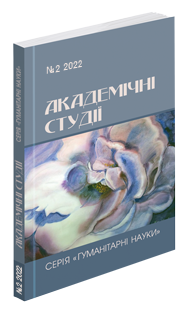Abstract
In the article the theory of derivational circulation between units of the lexical and phraseological levels of language is developed. The part of the derivation is considered, the primary (initial) element of which is the phraseological unit (PhU). It is claimed that the isomorphism of derivational processes at the lexical and phraseological levels enables the description of derivational transformations of phraseological units in connections and mediations with word-formation processes. Combinations of derived units with forming phraseological unit and among themselves can be studied as derivational pairs, chains, paradigms and nests. Turning to the nest organization of this part of the lexical and phraseological circulation, scientists, as a rule, limit themselves to the analysis of the combinations "formative PhU – derived PhU", "formative PhU – derived PhUs", "formative PhU – derived word", "formative PhU – derivatives words", that is, limit the contents of the nest. In the article it is suggested to consider a set of motivating (forming) phraseological unit and all its derivatives – both words and PhUs – organized by motivational relations as a phraseological nest. The thematic unity of the nest is built on the general semantics condensed in the forming phraseological, and the structural unity is based on the representation of at least one component of the original phraseological in the derivatives. Within the nest with the participation of wordforming and phrase-forming means and methods, the primary phraseological semantics is modified and mutated, undergoing derivational development not only in the field of phraseology, but also – more diversely – in the field of vocabulary. The analysis of phrase-derivative nests revealed the integrating role of the creative unit, which, in addition to the main phraseological one, also has a categorical-grammatical meaning. The typical semantic structure of nests with vertices – verb, substantive, adjective and adverbial phraseological units is described. At the same time, its prognostic character and the dependence of the filling of certain semantic places on the action of the selectivity of word and phrase formation – semantic, lexical, grammatical and component – are emphasized.
References
Архангельский В. Л. Устойчивые фразы в современном русском языке. Ростов н/Д : Изд-во Ростовского ун-та, 1964. 315 с.
Бушуй А. М. Словообразовательные возможности фразеологических единиц русского языка. Словообразование и номинативная деривация в славянских языках : тез. докл. республ. конференции. Гродно, 1982. Ч. 1. С. 15–18.
Бушуй А. М. К изучению деривационных процессов во фразеологии. Проблемы фразеологии : межвуз. сб. науч. трудов. 1980. С. 53–59.
Виноградов В. В. Русский язык. (Грамматическое учение о слове). М.-Л., 1947. 784 с.
Губарев В. П. Историческая фразеология и фразеологическая деривация (на материале немецкого языка). Деривация и история языка : межвуз. сб. науч. трудов. Пермь, 1987. С. 50–58.
Денисенко С. Н. Фразообразование в немецком языке : (фразеологическая деривация как системный фактор фразообразования). Львов : Высш. шк. Изд-во при Львовском гос. университете, 1988. 194 с.
Дмитренко О. П. Словотвірна продуктивність фразеологічних одиниць на позначення соціально-економічних реалій у сучасній німецькій мові. Studia Linguistica. 2012. Вип. 6. С. 93-98.
Петров А. В. Отфразеологические гнёзда в русском языке (на материале адъективных, адвербиальных и пропозициональных фразеологизмов). Культура народов Причерноморья : научный журнал. 2007. № 100. Т. 2. С. 74–81.
Попова А. Р. Система лексико-фразеологических блоков в структуре лексико-фразеологического комплекса. Слово, фразеологизм, текст в литературном языке и говорах : сб. науч. трудов. Орёл, 2010. С. 99–103.
Телия В. Н. О дополнительности слово- и фразообразовательных способов номинации в сфере обозначения предметных сущностей. Сборник научных трудов МГПИИЯ им. М. Тореза. 1980. Вып. 164. С. 170–179.
Ужченко В. Д., Ужченко Д. В. Фразеологія сучасної української мови : навч. посіб. Київ : Знання, 2007. 494 с.

